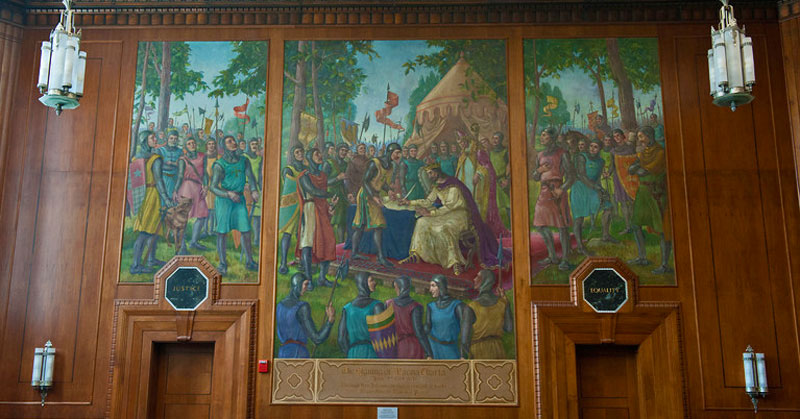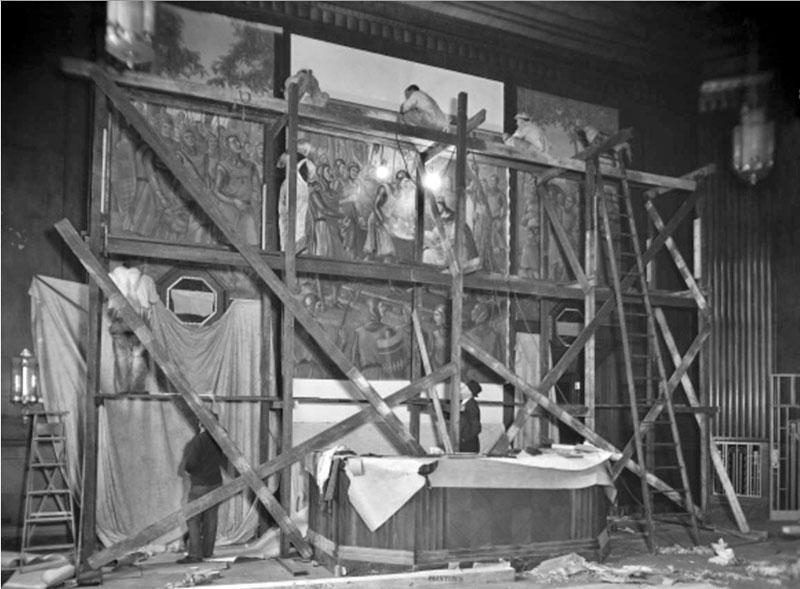You are here
Artworks: The Signing of the Magna Carta
This large 20' x 20' triptych entitled "The Signing of the Magna Carta" is in the old courtroom on the second floor of Federal Hall. The mural depicts the scene of the signing of the Magna Carta in 1215, and has the description “Through this Document Government Exists According to Law not Power”. It was funded by the Treasury Section of Fine Arts and painted by Frederick Webb Ross in 1935.
Frederick Webb Ross was born in Shelbyville, Indiana, on March 19, 1885 and attended Shortridge High School in Indianapolis. After studying art under William Forsyth in Indianapolis, Ross traveled to New York City and its Art Students League. Starting in 1911 Ross toured Europe but in June 1934, he completed "The Signing of the Magna Carta" in his New York studio, which was then transported to Terre Haute,


Installation of "The Signing of the Magna Carta", 1935
Image from Indiana Historical Society
The Magna Carta Room, Courtroom or even plain FD223 in Federal Hall was officially renamed as the Kenneth L. Smith and Theresa Kathryn Klein Smith Magna Carta Courtroom on September 24, 2021. In June 2021, Indiana State alumnus, Dr. Kenneth L. Smith, gave $1 million to the university to honor his late wife and support scholarships in accounting, economics, finance, and history. Smith, who taught economics and finance for 42 years at the university level, met his wife at the University of North Texas. The couple was married for 32 years prior to Theresa’s passing in 2019.

Kenneth and Theresa Smith
In recognition of the gift, the Board of Trustees approved the naming of the Kenneth L. Smith and Theresa Kathryn (Klein) Smith Magna Carta Courtroom on the second floor of the Federal Building, home of the Scott College of Business. The space, once a federal courtroom, features a mural depicting the 1215 signing of the Magna Carta. It was painted in 1935. Smith said an elementary school field trip to what was then the Terre Haute Post Office and Federal Building left a lasting impression.

Renaming of the Courtroom
<< Read More >>
Dr. Kenneth L. Smith’s personal connection for giving to establish four scholarships in Accounting, Economics, Finance and History and name the Magna Carta Courtroom at Indiana State University.
The Magna Carta Libertatum (Latin for Great Charter of Freedoms), commonly referred to simply as the Magna Carta, represents the confluence of business disciplines (Accounting / Economics / Finance) and Social Sciences (Economics / Anthropology / History / Political Science) as we know them today. The Magna Carta was originally intended to provide barons a degree of freedom from King John in 1215. However, by limiting the government and executive powers over his barons, and by establishing legitimate legal rights, albeit for the nobility only, the document gradually diffused a degree of freedom and due process all over the world for several centuries to come.
This agreement provided for the allocation of scarce resources – would the King be allowed to tax the barons or would they be free to decide how to allocate their funds as they pleased? As such, the Magna Carta is an Economic document. Finance also involves allocating economic scarce resources (income) – between today and the future (e.g., borrowers v. lenders) or between credit and ownership (debt v. equity). Modern Tax Accounting involves making economic decisions to allocate scarce resources as well (e.g., deciding the best method for charitable giving). Modern Managerial Accounting analyzes the allocation decisions of managers in the pursuit of an organization's goals (e.g., decisions regarding board members, management, executive compensation, stock options). Financial Accounting involves reporting these allocation decisions (e.g., short-term vs. long-term debt decisions, liquid vs. illiquid assets) to investors.
Thus, the Magna Carta represents the intersection of Economic decision-making involving accounting and finance that has been ongoing for millennia (as long as trade has existed). Indeed, those who think and write Historically, in terms of centuries rather than years or even decades, are among the most educated.
Dr. Kenneth L. Smith
ISU Alumnus ’73, ’74